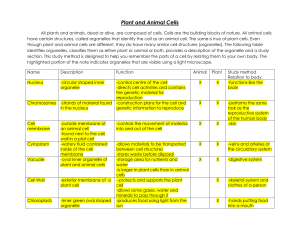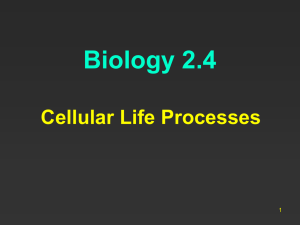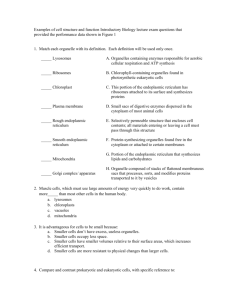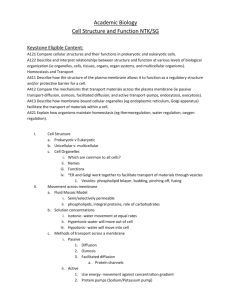cell structures and functions
advertisement
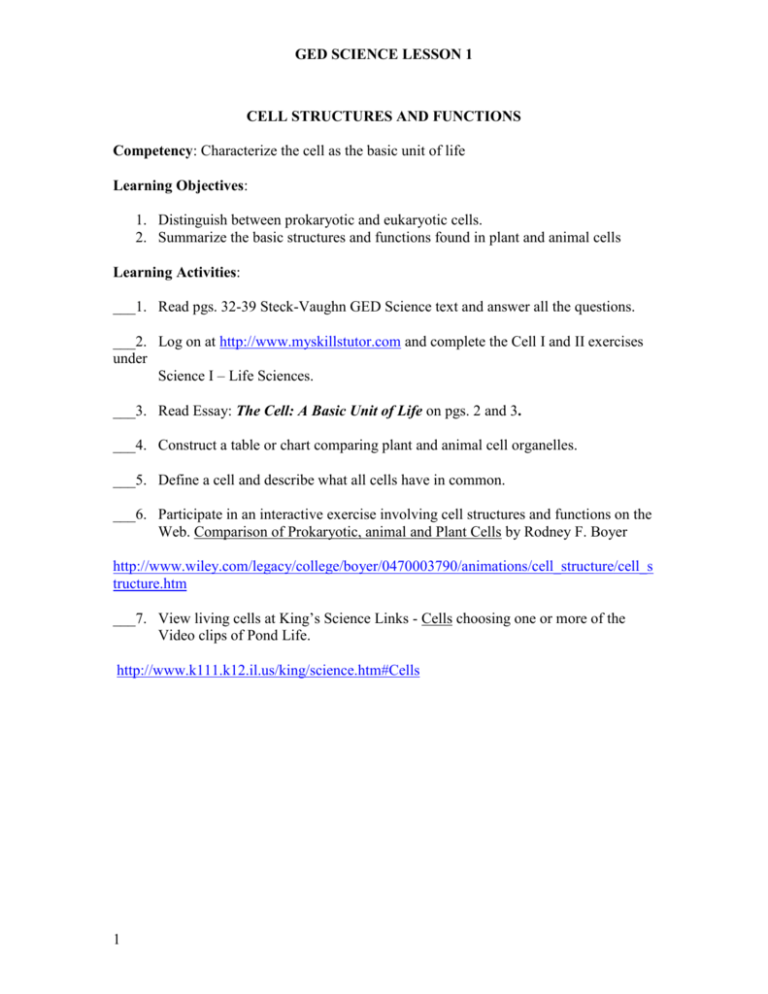
GED SCIENCE LESSON 1 CELL STRUCTURES AND FUNCTIONS Competency: Characterize the cell as the basic unit of life Learning Objectives: 1. Distinguish between prokaryotic and eukaryotic cells. 2. Summarize the basic structures and functions found in plant and animal cells Learning Activities: ___1. Read pgs. 32-39 Steck-Vaughn GED Science text and answer all the questions. ___2. Log on at http://www.myskillstutor.com and complete the Cell I and II exercises under Science I – Life Sciences. ___3. Read Essay: The Cell: A Basic Unit of Life on pgs. 2 and 3. ___4. Construct a table or chart comparing plant and animal cell organelles. ___5. Define a cell and describe what all cells have in common. ___6. Participate in an interactive exercise involving cell structures and functions on the Web. Comparison of Prokaryotic, animal and Plant Cells by Rodney F. Boyer http://www.wiley.com/legacy/college/boyer/0470003790/animations/cell_structure/cell_s tructure.htm ___7. View living cells at King’s Science Links - Cells choosing one or more of the Video clips of Pond Life. http://www.k111.k12.il.us/king/science.htm#Cells 1 GED SCIENCE LESSON 1 ESSAY: THE CELL: A BASIC UNIT OF LIFE Cells are the lowest level of biological organization that fully displays the characteristics of life. Living cells are organized, have energy requirements to maintain that organization, are capable of responding to their environment, reproduce and pass on their genetic material, and are able to adapt or evolve. All living things are composed of cells and have come form previously existing cells. Most cells are very small and need to be viewed with a microscope. There are physical laws that limit the size that cells can grow. There is a great deal of outward diversity of cell shapes, some cells appearing long and spindle-shaped while others may appear as rods, crescents, or ovals. Images of cells can sometimes appear flat and 2-dimensional unless special microscopes are used. It is important to view living cells so that you can see they contain volume. Some cells can actually swim very quickly in a fluid because of tail-like structures while others can clearly crawl, albeit very slowly! Despite obvious differences in the outward appearances of cell types, cells actually share many common structures. What do all cells have in common? All cells contain an outer cell membrane that acts as a boundary between the inside of the cell and the external environment. This membrane allows the transport of various materials back and forth across it. It allows the cell to take in nutrients and get rid of waste products. All cells also contain the chemical DNA, deoxyribonucleic acid. The DNA is the hereditary material that tells the cell what products to make. It is this DNA that must be duplicated prior to cell reproduction so that a set of instructions can be transmitted to the next generation. Besides DNA and a cell membrane, all cells contain a gel-like substance known as cytoplasm that fills the interior of the cell. Cells may exist by themselves and live independently (unicellular) or they maybe part of a larger multicellular organism such as yourself. Scientists recognize two basic types of cells based on their internal organization. The prokaryotes are small, simple one-celled organisms that structurally can be compared to an efficiency apartment-everything in one room. Prokaryotes are mainly bacteria (Kingdom Monera) and their DNA is not protected within a membrane bound structure but rather lies free in the cytoplasm. The other major type of cell, the Eukaryotes, are much larger than prokaryotes, are more complex, and their DNA is housed within a membrane bound structure known as the nucleus. This is the control center of the cell. Eukaryotes are partitioned within the cytoplasm into many smaller structures or compartments called organelles. These organelles are made of membrane and help organize the activities of these more complex cells. Eukaryotic cells include those organisms found in the other four Kingdoms of Life, the Protista, Fungi, Plants, and Animals. 2 GED SCIENCE LESSON 1 ESSAY: THE CELL: A BASIC UNIT OF LIFE Major cellular organelles found within eukaryotic cells include the following: mitochondrion, nucleus, endoplasmic reticulum, Golgi apparatus or Golgi body, ribosomes, vacuoles, and lysosomes. Each has its own shape and function. The mitochondrion is involved in energy conversions while the endoplasmic reticulum synthesizes lipids and guides and transports molecules within its channels. Ribosomes help assemble proteins. The Golgi bodies act as warehouses for products produced in the endoplasmic reticulum and they add finishing touches to these products. Vacuoles store cell products or water. Lysosomes digest foreign material and nutrients sometimes. All of these organelles can be found in both plant and animal cells; however, plant cells contain two additional structures not found in animal cells. Plant cells contain chloroplasts, which are organelles that help capture the energy of the sun to help produce sugars. Plant cells also have a cell wall that surrounds the cell membrane, which is rigid and provides support to the cell. The numbers of each of the organelles varies considerably between cell types and whether the cell has large energy needs or is actively growing. 3






